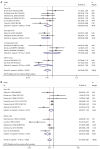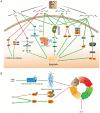Association and mechanism of garlic consumption with gastrointestinal cancer risk: A systematic review and meta-analysis
- PMID: 35222725
- PMCID: PMC8867184
- DOI: 10.3892/ol.2022.13245
Association and mechanism of garlic consumption with gastrointestinal cancer risk: A systematic review and meta-analysis
Abstract
Gastrointestinal cancer is one of the most commonly diagnosed cancer type worldwide, with millions of cases per year. The aim of this review was to investigate the relationship between garlic intake and the risk reduction of gastrointestinal cancer. We performed saturated data mining on various public domain databases, including PubMed (https://pubmed.ncbi.nlm.nih.gov/), Embase (https://www.embase.com/landing?status=grey), and Cochrane Library (https://www.cochranelibrary.com/), with key terms including: 'garlic', 'allium', 'stomach', 'gastric', 'colon', 'neoplasms', 'cancer' and 'tumor'. Furthermore, we identified additional references through expert manual curation. Finally, a meta-analysis was conducted to determine whether garlic intake reduces the risk of gastric and/or colorectal cancer. The association between garlic intake and reduction in the risk of gastric cancer [odds ratio (OR)=0.65, 95% confidence interval (CI)=0.49-0.87, P<0.001] were clear. Nine studies on garlic intake and colorectal cancer showed that garlic reduced cancer risk with a statistical significance (OR=0.75, 95% CI=0.65-0.87, P<0.001). We summarized that four main organic sulfides in garlic, diallyl disulfide (DADS), diallyl trisulfide (DATS), S-allylmercaptocysteine (SAMC) and allicin, may contribute to the regulation of tumor cell apoptosis, migration and the cell cycle. We identified the association between garlic intake and reduced risk of gastric and colorectal cancers and hypothesized that the active ingredients in garlic may act on multiple pathways to reduce the risk of gastrointestinal tumors according to published papers. Importantly, the potential tumor-preventing effect of these garlic ingredients warrants further investigation in regards to the specific mechanism of the underlying antitumor activities.
Keywords: garlic; gastric cancer; gastrointestinal cancer; meta-analysis.
Copyright: © Wang et al.
Conflict of interest statement
The authors declare that they have no competing interests.
Figures








Similar articles
-
Potential antitumor activity of garlic against colorectal cancer: focus on the molecular mechanisms of action.Eur J Nutr. 2023 Sep;62(6):2347-2363. doi: 10.1007/s00394-023-03166-0. Epub 2023 May 4. Eur J Nutr. 2023. PMID: 37140645 Review.
-
Meta-analysis: Does garlic intake reduce risk of gastric cancer?Nutr Cancer. 2015;67(1):1-11. doi: 10.1080/01635581.2015.967873. Epub 2014 Nov 20. Nutr Cancer. 2015. PMID: 25411831
-
Diallyl sulfide, diallyl disulfide, and diallyl trisulfide inhibit migration and invasion in human colon cancer colo 205 cells through the inhibition of matrix metalloproteinase-2, -7, and -9 expressions.Environ Toxicol. 2013 Sep;28(9):479-88. doi: 10.1002/tox.20737. Epub 2011 Jun 21. Environ Toxicol. 2013. PMID: 21695758
-
Potential beneficial effects of garlic in oncohematology.Mini Rev Med Chem. 2011 Jun;11(6):461-72. doi: 10.2174/138955711795843293. Mini Rev Med Chem. 2011. PMID: 21561411
-
Allicin and Digestive System Cancers: From Chemical Structure to Its Therapeutic Opportunities.Front Oncol. 2021 Apr 27;11:650256. doi: 10.3389/fonc.2021.650256. eCollection 2021. Front Oncol. 2021. PMID: 33987085 Free PMC article. Review.
Cited by
-
Potential antitumor activity of garlic against colorectal cancer: focus on the molecular mechanisms of action.Eur J Nutr. 2023 Sep;62(6):2347-2363. doi: 10.1007/s00394-023-03166-0. Epub 2023 May 4. Eur J Nutr. 2023. PMID: 37140645 Review.
-
The potential of diallyl trisulfide for cancer prevention and treatment, with mechanism insights.Front Cell Dev Biol. 2024 Sep 30;12:1450836. doi: 10.3389/fcell.2024.1450836. eCollection 2024. Front Cell Dev Biol. 2024. PMID: 39403128 Free PMC article. Review.
-
Therapeutic effects of garlic (Allium sativum) on female reproductive system: A systematic review.Heliyon. 2023 Nov 20;9(12):e22555. doi: 10.1016/j.heliyon.2023.e22555. eCollection 2023 Dec. Heliyon. 2023. PMID: 38076037 Free PMC article.
-
Lifestyle, dietary pattern and colorectal cancer: a case-control study.BMC Nutr. 2024 Oct 17;10(1):138. doi: 10.1186/s40795-024-00950-x. BMC Nutr. 2024. PMID: 39420424 Free PMC article.
-
Garlic consumption and colorectal cancer risk in US adults: a large prospective cohort study.Front Nutr. 2023 Dec 6;10:1300330. doi: 10.3389/fnut.2023.1300330. eCollection 2023. Front Nutr. 2023. PMID: 38125729 Free PMC article.
References
Publication types
LinkOut - more resources
Full Text Sources
